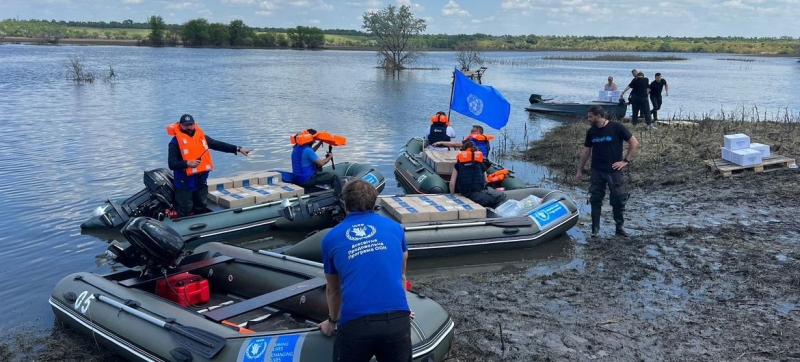
UN humanitarian agencies and their partners are delivering aid to Ukrainians affected by the destruction of the Kakhovka Dam. Ukraine: destruction of the Kakhovka Dam – a year later Peace and security
Exactly a year ago, the destruction of the Kakhovka dam led to the flooding of more than 620 square kilometers of Ukrainian territory. This was one of the most significant incidents of damage to civilian infrastructure since the start of the full-scale Russian invasion in February 2022.
The collapse of the dam claimed lives and forced thousands of residents of the affected areas to flee their homes. The land was devastated and livelihoods destroyed on both sides of the front line. The Kakhovka Reservoir, the main source of drinking water for more than 700 thousand people in southern Ukraine, has been depleted. The catastrophic environmental consequences of the flood will be felt for many years to come – and not only in Ukraine.
UN Response
UN promptly mobilized a response that continues to this day. Unfortunately, refusals on the part of the Russian Federation prevented the Organization from helping people in Russian-occupied areas, reports from the UN in Ukraine.
Read also:
Experts: the damage caused by the breakthrough of the Kakhovka Dam is largely irreversible
In areas under Ukrainian control, retaliatory measures began from day one. The UN and its partners provided life-saving water, food, health services, financial support, social protection and transportation to nearly 200,000 people in just a few days. Despite the challenges, in June 2023 alone, 20 inter-agency convoys carrying nearly 80 trucks delivered relief supplies to thousands of people affected by the disaster, in addition to assistance provided separately by UN agencies and NGOs. Some supplies were delivered by boats and amphibious trucks to ensure access to all people stranded by the flood.
Water, food, medical and cash assistance
The UN and humanitarian organizations have delivered nearly 20 million liters of drinking water, supported nearly 70 local water utilities, and helped drill water wells, pumps, taps, water treatment plants and water storage facilities.
Cash assistance was provided to almost 40 thousand people, and more than 200 thousand rations of ready-made food were distributed in the Kherson and Nikolaev regions. The provision of medical assistance by mobile teams in the affected areas was also a priority. The UN delivered medical equipment, emergency kits, trauma kits, diagnostic tests and treatments for acute diarrhea, including those caused by cholera. There were enough medicines to provide medical care to almost 38 thousand people for three to six months.
Almost 65 thousand emergency repair items and household supplies were distributed among residents of the Kherson region whose homes were damaged. Since the early days of the disaster, child protection organizations have provided services to more than 14,000 people, including 7,300 children, by sending multidisciplinary mobile teams to the affected areas. They provided mental health and psychosocial support services, delivered essential supplies, and provided child protection case management and legal assistance.
Work in progress
The UN continues to support communities in southern Ukraine as they recover from the disasters caused by the Russian invasion. This includes support for needs assessments and environmental impact assessments that will help plan future responses.
In the months following the disaster, the UN and its partners repaired the homes of hundreds of people and sent nearly 200 medical workers to southern Ukraine to ensure continuity of care despite the destruction. The priority task was the repair and construction of water supply sources: mobile water treatment facilities were deployed in the Kherson and Dnieper regions, and water pumps were sent to Nikopol. Work was also carried out to increase the water supply from the Karachunovsky water management complex, which provided water to 600 thousand people in Krivoy Rog.
